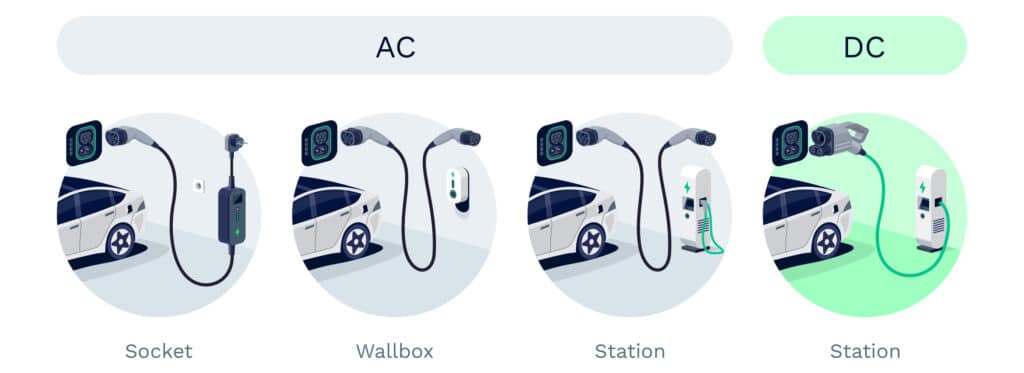AC vs. DC Charging: Understanding the Differences
September 14, 2023
In the rapidly advancing realm of electric vehicles (EVs), a common query is the distinction between AC and DC charging. The Pacific Northwest, renowned for its verdant landscapes and eco-conscious ethos, is a haven for EV enthusiasts. From the vibrant streets of Seattle, Washington to the scenic vistas of Oregon, it’s evident that EVs represent more than just a passing trend—they signify a transformative shift in transportation.
To truly harness the benefits of this transition, it’s crucial to grasp the intricacies of the charging systems that fuel our electric journeys. While AC and DC charging might initially seem like daunting tech lingo, fear not! We’re here to demystify these terms, ensuring that drivers in Washington and Oregon can recharge their EVs with ease. Let’s delve deeper!
AC vs. DC Chargers: The Key Differences
Alternating Current (AC) and Direct Current (DC) represent the two primary electric currents utilized in EV charging. AC charging, encompassing Level 1 and Level 2, taps into the power supply of homes or public charging stations and tends to be more time-consuming. The vehicle’s onboard charger transforms this AC power into DC to replenish the battery.
Conversely, DC charging—often termed fast or rapid charging—directly powers the battery, sidestepping the onboard charger, resulting in a swifter charge. This mode is predominantly available at specialized EV charging hubs and is optimal for extended journeys or brisk top-ups during travels.

AC Charging
Often dubbed Level 1 or Level 2 charging, Alternating Current (AC) charging is the prevalent choice for home or public charging points. Level 1 harnesses standard 120-volt outlets, whereas Level 2 draws from a 240-volt source, akin to household appliances like dryers or ovens. When an EV connects to an AC source, its onboard charger undertakes the task of converting AC power into Direct Current (DC) suitable for battery storage.
Given its relatively leisurely pace compared to DC fast charging, AC charging is ideal for overnight sessions or during daily activities like work or errands. It offers a practical and economical solution to keep your EV primed for the journey ahead.
DC Charging
Direct Current (DC) charging, labeled as fast or rapid charging, presents a markedly faster method to energize your EV. Bypassing the onboard charger, DC charging directly feeds the battery, significantly accelerating the charging phase. These potent chargers are typically stationed at dedicated EV charging centers, akin to traditional gas stations. While DC chargers might be scarcer and pricier than their AC counterparts, they revolutionize long-distance travels by offering rapid refuels. With DC fast charging, batteries can reach up to 80% capacity in a mere 20 to 30 minutes, minimizing wait times and amplifying the joy of driving.
Decoding EV Charging Curves
AC Charging Curve
The AC charging curve visually depicts the rate at which an EV charges from an AC source. It commences swiftly but decelerates, especially post the 80% mark, to safeguard battery longevity and vitality. This pattern is colloquially termed a “tapered” charge.
DC Charging Curve
The trajectory of the DC charging curve starts with a high-speed charge, gradually diminishing as the battery nears the 80% threshold. This moderation prevents excessive heat and ensures battery longevity. Thus, while DC charging offers an initial rapid boost, the pace moderates as the battery approaches full capacity.
Weighing the Pros and Cons of AC and DC Charging
AC Charging
Pros
- Ubiquity: AC charging is feasible via regular household outlets (Level 1) or enhanced home/public stations (Level 2).
- Economical: Home charging, especially during off-peak nocturnal hours, often proves more wallet-friendly than rapid charging stations.
- Battery Care: The gradual charging pace is less taxing on the battery, potentially enhancing its lifespan.
Cons
- Pace: Depending on the AC level and the capacity of the EV’s onboard charger, full charges might span several hours.
- Potential Installations: Level 2 home charging might necessitate the setup of a dedicated EV charger and electrical system modifications.
- Long Trips: For extended travels, AC charging might prove less practical due to its prolonged charging duration.
DC Charging
Pros
- Rapid Charge: DC fast charging trumps AC charging in speed, often revitalizing up to 80% of a battery within 20-30 minutes.
- Travel-friendly: The briskness of DC charging is a boon for lengthy trips requiring swift energy boosts.
- Direct Power: DC charging directly energizes the battery, eliminating the need for onboard conversion.
Cons
- Cost: Regular usage of DC fast charging might be pricier than AC charging.
- Scarce Availability: DC fast chargers aren’t as ubiquitous as AC chargers.
- Battery Strain: Consistent rapid charging might strain the battery over time due to the heat generated during the process.
Your Oregon and Washington Electric Vehicle Headquarters
In the dynamic landscape of electric vehicles, understanding the nuances of AC and DC charging is paramount. As the Pacific Northwest embraces this sustainable shift in transportation, it’s essential to have trusted experts to guide the way.
Dick Hannah Dealerships stand out as the local EV authorities, offering unparalleled insights and expertise when it comes to electric cars. Whether you’re a seasoned EV driver or just beginning your electric journey, rely on Dick Hannah Dealerships to illuminate the path forward.
Contact Us